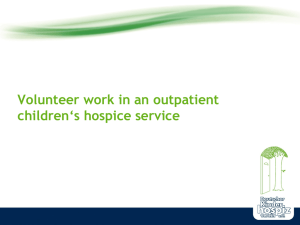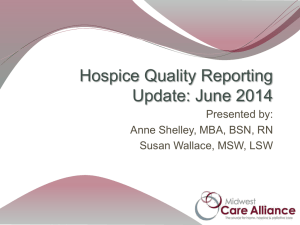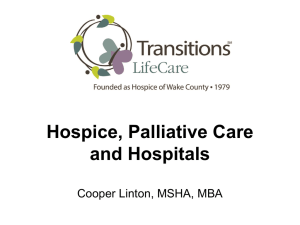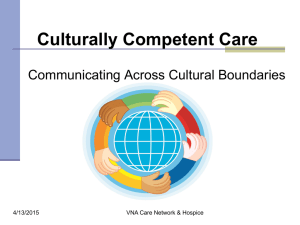PowerPoint File - Take Charge of Your Life
advertisement
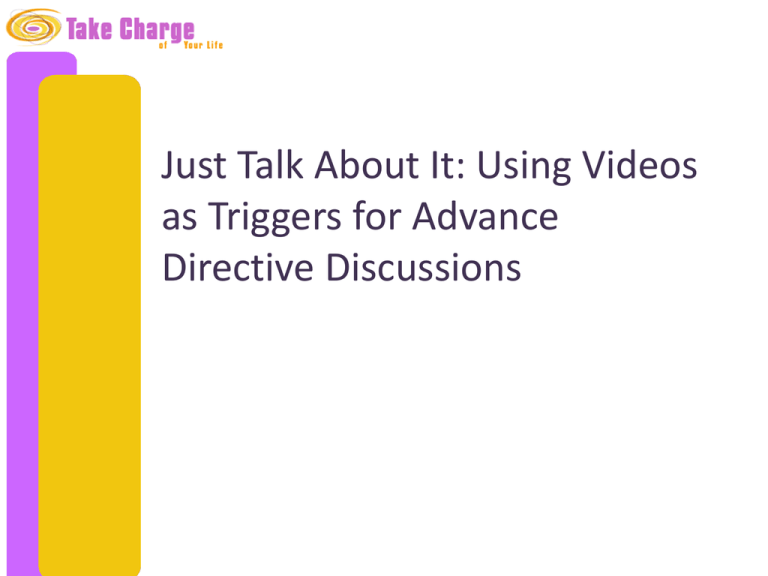
Just Talk About It: Using Videos as Triggers for Advance Directive Discussions Objectives 1. Review the process of developing advance directives 2. Identify the benefits of using videos as triggers for advance directive discussions 3. Describe how to facilitate advanced directive discussions Take Charge of Your Life The mission of the Take Charge of Your Life Partnership is to educate, support and empower all people to deal with end-of-life issues through outreach to consumers, professionals, community organizations and corporations. History: 2000 • On Our Own Terms: Moyers on Dying – If we are going to change the way we die, then we are going to have to start talking about it, and then, take action. • End-of-Life Partnership of Western PA • National Issues Forum History: 2001-2002 • 501(c)(3) non-profit status • Take Charge of Your Life campaign • Rethinking End-of-Life Care – Continuing the Conversation • And Thou Shalt Honor History: 2003-2004 • • • • • Take Charge of Your Life Partnership Take Charge Online Rallying Points grant Heart2Heart online interviews Award of Excellence from Rallying Points History: 2005-2006 • Coalition for Quality at the End of Life (CQEL) • Community Conversation • Plenary meetings History: 2007… • Improving End-of-Life Experience's for Pennsylvanians • Just Talk About It videos TakeChargeofYourLife.org FAQ’s Definitions • Advance Directives • Living Will • Power of Attorney Definitions • Healthcare Agent • POLST/MOLST Just Talk About It Video Project • • • • Raise awareness Provoke thought Stimulate discussion Motivate participants toward action Discussion Guides • Individual • Group Just Talk About It Discussion Video Guides • Advance Care Planning – A Family Way – A Friend in Need – Where There’s A Will • Caregiving – Support Group – So Guilty – Conference Call Just Talk About It Discussion Video Guides • Hospice and Palliative Care – Hospice in the Home – Sooner Rather Than Later – Nursing Home Hospice • Pain Management – What’s Right For You – I’m Fine – Old Buddies Group Discussion Guide • • • • • • • Gather a group Review the topics Select one or more scenarios Introduce a topic Break into groups Discuss the challenges and opportunities Regroup and empower participants to “take charge” Just Talk About It Video Discussion Group Guides • Introduction • Scenarios – Discussion points • Questions • Possible answers • Options ADVANCE DIRECTIVE VIDEOS A Family Way A Family Way Why would someone who is just having knee surgery need an advance care directive (living will)? A Family Way What are the barriers to completing an advance directive (living will)? A Family Way What are the advantages of discussing an advanced directive (living will) with your family and healthcare practitioner? A Friend in Need A Friend in Need What important factors should you consider about yourself and about the person you will choose as health care agent? A Friend in Need How might religious beliefs, age, marital status and ethnic background impact your decision about naming a health care agent? A Friend in Need What are the benefits of naming a health care agent? Where There’s A Will Where There’s A Will When thinking about end-of-life issues, how might biases or stereotypes affect those who are physically or mentally challenged? Where There’s A Will What other groups of people might face the similar fears of not having their wishes respected? Where There’s A Will How can advance care planning restore a sense of “control” to those who are mistakenly seen as “unable to think for themselves”? CAREGIVING VIDEOS Support Group Support Group What barriers keep family caregivers from seeking support? Support Group What are some of the challenges and fears of older family caregivers? – …younger family caregivers? Support Group Why is it important for caregivers to take care of themselves? Go Guilty So Guilty In what ways could the burden of responsibility impact the wellbeing of the family caregiver: physically, emotionally, socially, and spiritually? So Guilty How can families, friends, and healthcare professionals best support the full-time family caregiver to prevent burnout? So Guilty How can the full-time family caregiver best identify and communicate his/her needs to family, friends, and healthcare professionals? Conference Call Conference Call What factors have made “long-distance caregiving” a necessity for many families? Conference Call What are some of the caregiving challenges and concerns of large families? – …of very small families? Conference Call In addition to conference calling, what are some creative ways in which families can participate in the care of a loved one when they live at a distance? HOSPICE AND PALLIATIVE CARE VIDEOS Hospice in the Home Hospice in the Home What cultural, ethnic, religious and gender beliefs might interfere with accepting “outside help”? Hospice in the Home What misunderstandings about hospice prevent eligible patients from receiving this care? Hospice in the Home In what ways can hospice care at home benefit the patient? – ... the family?... – the patient’s primary care provider? Sooner Rather Than Later Sooner Rather Than Later What are some reasons why families receive hospice services “too late” (or not at all)? Sooner Rather Than Later The mother in this video does not look sick and is not actively dying -- why do you think she is eligible for hospice? Sooner Rather Than Later How can receiving hospice services “sooner rather than later” benefit the caregiver in the short-term? – …over the long-term? – …after the death? Nursing Home Hospice Nursing Home Hospice Why do nursing home patients sometimes not receive the services of hospice? Nursing Home Hospice What are the advantages to using hospice services within the nursing home setting for the patient? – …the family? – …the nursing home staff? – …the hospice staff? Nursing Home Hospice What are some of the challenges that confront family members who live at a distance compared to family members who live nearby and have the bulk of the caregiving responsibility? PAIN MANAGEMENT VIDEOS What’s Right For You What’s Right For You In what ways does under-managed pain affect the quality of life of the individual in pain? – …of the family? What’s Right For You What are some different attitudes that people have about pain? What’s Right For You Why do some people stop taking their pain medication? I’m Fine I’m Fine What attitudes and myths prevent individuals from asking for or accepting adequate pain management? I’m Fine What obstacles do health care providers face in providing effective pain treatment? I’m Fine Consider the statement made by the nurse: “If you are having pain, then we need to do a better job.” What are some ways that health care providers can “do a better job”? Old Buddies Old Buddies What are some of the barriers to seeking non-medical treatments? Old Buddies How might age, gender, and ethnic background play a role in the pursuit of treatment for chronic pain? Old Buddies How could patients and their health care providers become better informed about non-medical treatments to relieve pain or complement a current pain management regime? Advance Directive References • Pew Research Center for the People and the Press. (2006). More Americans discussing – and planning – end-of-life treatment: Strong public support for right to die. Washington, DC: Author. Retrieved June 6, 2010 from http://people-press.org/reports/pdf/266.pdf. • Prendergast, T.J. (2001). Advance care planning: Pitfalls, progress, promise. Critical Care Medicine, 29(2) Supplement, N34-N39. Caregiving References • Alzheimer’s Association and National Alliance for Caregiving. (2004). Families care: Alzheimer’s caregiving in the United States. Chicago, IL: Alzheimer’s Association and Bethesda: National Alliance for Caregiving. • Houser, A., & Gibson, M.J. (2008). Valuing the invaluable: The economic value of caregiving, 2008. Update. AARP Public Policy Institute, Washington, DC. • Scharlach, A., Sirotnik, B., Bockman, S., Neiman, M., Ruiz, C., & Dal Santo, T. (2003). A profile of family caregivers: Results of the California statewide survey of caregivers. Berkeley: Center for the Advanced Study of Aging Services, U.C. Berkeley Press. • Schulz, R., & Beach, S.R. (1999). Caregiving as a risk factor for mortality: The caregiver health effects study. Journal of the American Medical Association, 282, 2215-2219. Hospice and Palliative Care Reference • National Hospice and Palliative Care Organization. (2009). Facts and figures: Hospice care in America. Washington, DC. Pain Management References • Kirsch, B., Berdine, H., Zablotsky, D., et al. (2000). Management strategy: identifying pain as the fifth vital sign. Veterans Health System Journal, 49–59. • Phillips, D., for the Joint Commission on Accreditation of Healthcare Organizations. (2000). JCAHO pain management standards are unveiled. Journal of the American Medical Association, 284, 428-429.

